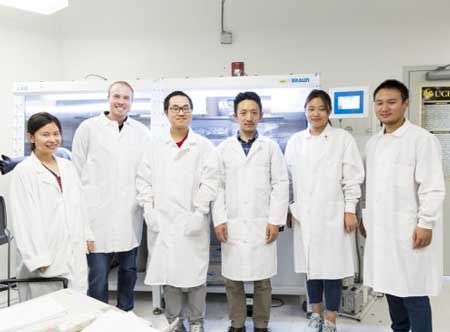| Posted: Sep 19, 2017 |
Researchers' work pushes battery technology forward
(Nanowerk News) University of Central Florida Assistant Professor Yang Yang’s research group has developed two promising energy storage technologies in its work with sustainable energy systems.
|
|
Yang sees revolutionary systems that can produce and store energy inexpensively and efficiently as a potential solution to energy and environmental crises.
|
|
“We try to convert solar energy either to electricity or chemical fuels. We also try to convert chemical fuels to electricity. So, we do different things, but all of them are related to energy,” said Yang, who came to UCF in 2015 and has joint appointments in the NanoScience Technology Center and the Department of Materials Science and Engineering.
|
|
One of the researchers’ technologies would upgrade the lithium-based batteries that are ubiquitous in today’s laptops, smartphones, portable electronics and electric vehicles. The other offers a safer, more stable alternative than lithium batteries.
|
 |
| Researchers Zhao Li, Kyle Marcus, Kun Liang, Assistant Professor Yang Yang, Guanzhi Wang and Wenhan Niu are developing new energy technologies. (Image: UCF)
|
Electrode For High-Performance Battery
|
|
As recently reported in the scholarly journal Advanced Energy Materials ("NiS2/FeS Holey Film as Freestanding Electrode for High-Performance Lithium Battery"), the UCF researchers designed a new type of electrode that displays excellent conductivity, is stable at high temperatures and cheap to manufacture. Most significantly, it enables a high-performance lithium battery to be recharged thousands of times without degrading.
|
|
Batteries generate electrical current when ions pass from the negative terminal, or anode, to the positive terminal, or cathode, through an electrolyte.
|
|
Yang’s group developed a battery cathode created from a thin-film alloy of nickel sulfide and iron sulfide. That combination of materials brings big advantages to their new electrode.
|
|
On their own, nickel sulfide and iron sulfide each display good conductivity. Conductivity is even better when they’re combined, researchers found.
|
|
They were able to boost conductivity even more by making the cathode from a thin film of nickel sulfide-iron sulfide, then etching it to create a porous surface of microscopic nanostructures. These nanopores, or holey structures, greatly expand the surface area available for chemical reaction.
|
|
“This is really transformative thin-film technology,” Yang said.
|
|
All batteries eventually begin degrading after they’ve been drained and recharged over and over again. Quality lithium-based batteries can be drained and recharged about 300 to 500 times before they begin to lose capacity. Tests show a battery with the nickel sulfide-iron sulfide cathode could be depleted and recharged more than 5,000 times before degrading.
|
|
Researchers Kun Liang and Kyle Marcus from Yang’s group worked on the project. Collaborators included Le Zhou, Yilun Li, Samuel T. De Oliveira, Nina Orlovskaya and Yong-Ho Sohn, all of UCF, and Shoufeng Zhang of Jilin University in China, and Yilun Li of Rice University.
|
New Catalyst for Better Energy Storage
|
|
Graduate student researchers in Yang’s lab also developed a new catalyst for a high-efficiency battery that has several advantages over conventional ones.
|
|
Metal-air batteries, fuel cells and other energy storage and conversion applications rely on chemical reactions to produce current. In turn, those reactions need an efficient catalyst to help them along. Precious metals including platinum, palladium and iridium have proven to be efficient catalysts, but their high cost and poor stability and durability make them impractical for large-scale commercialization.
|
|
Researchers in Yang’s group led by Wenhan Niu, Zhao Li and Kyle Marcus developed a new process for creating a catalyst with a substrate of graphene, a highly conductive two-dimensional material with the thickness of a single atom.
|
|
As reported last week in Advanced Energy Materials ("Surface-Modified Porous Carbon Nitride Composites as Highly Efficient Electrocatalyst for Zn-Air Batteries"), they showed the effectiveness of their catalyst’s nanomesh-like structure by testing it in a zinc-air battery, demonstrating its capability of being depleted and recharged many times.
|
|
The electrocatalyst is safer and more stable than the volatile compounds found in lithium batteries, and can function in rain, extreme temperatures and other harsh conditions. And without the need for precious metals, it can be manufactured more cheaply.
|

